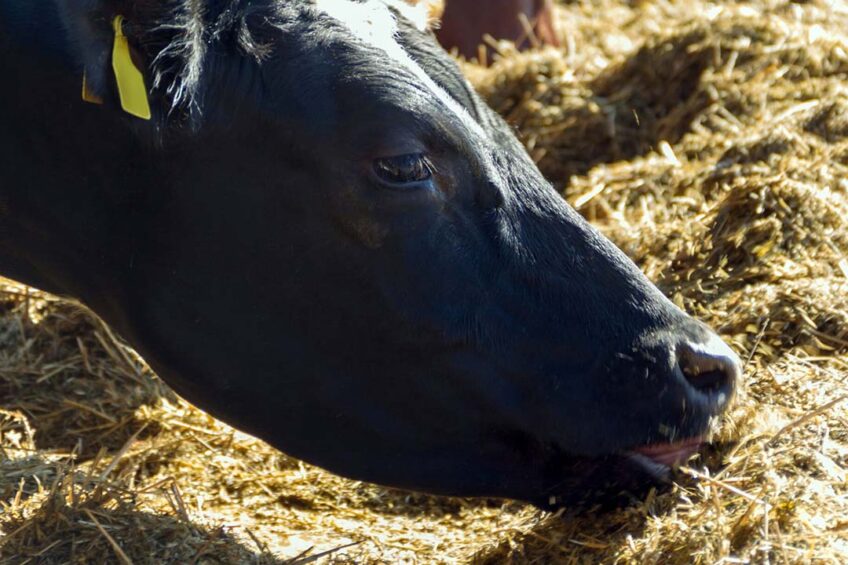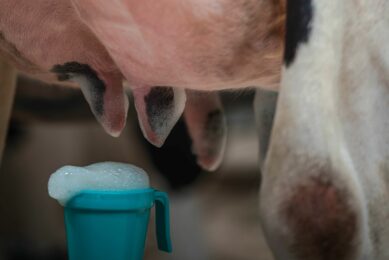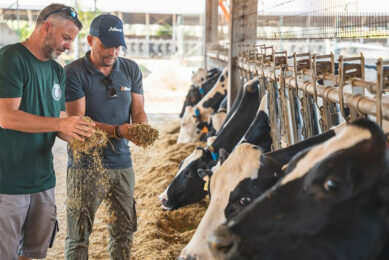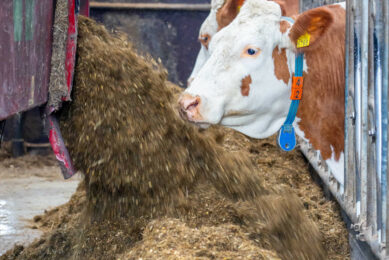Impact of feeding too much concentrates at milking

With more farmers opting to install automatic milking systems, attention should be given to whether cows have enough time to eat sufficient levels of concentrates while milking.
As cows spend less time being milked during each visit to the robot, it could be assumed they may not be consuming enough concentrates for maintenance and production. To counteract this problem, some farmers are installing out-of-parlour feeders to allow for extra concentrate intake, but could these have a detrimental impact on robot visit frequency?
Study
That’s exactly what a study in Northern Ireland, undertaken by AFBI, was set up for. AFBI examined the benefits of the robotic systems and how various feeding systems affected milking, yield and concentrate usage.
One of the core aspects of the study focused on the assumption that when farmers, particularly in Northern Ireland, switch to an automatic milking system they typically also shift to an year-round calving pattern. This move results in varied energy requirements within the herd and meeting these varied needs of individual cows through a partial mixed ration (PMR) is often very difficult.
There is therefore a need to provide the cows that have a with a high energy requirement (usually in early lactation and for high-yielding cows) with supplementary concentrate. Typically, this is done in the milking robot feed station or through out-of-parlour feeders.
Concentrate consumption
Within automatic milking systems, the milking robot feeder seems the natural choice to feed the cows concentrates. However, the amount of concentrate a cow is able to consume is limited by her milking frequency, milking time, and eating speed.
These can all result in cows simply not having enough time in the milking robot to consume an adequate amount of concentrates. Out-of-parlour feeders have been suggested as a useful source of additional concentrate for automatic milking systems.
However, as concentrate feed provision within the robot is used to motivate cows to get milked, it is important to understand if feeding additional concentrate with out-of-parlour feeders would have a detrimental impact on robot visit frequency.
Study details
For the purposes of this study, AFBI housed 48 cows using 1 milking robot and 2 out-of-parlour feeders. PMR containing 80% grass silage and 20% wholecrop, plus 2kg concentrate blend per cow, was fed once daily.
Cows were split into 2 different groups and fed differently to assess their activity. The first group, the ‘robot high’ cows, received 80% of their additional concentrate ration in the milking robot feeding station, and 20% through out-of-parlour feeders. The second group, the ‘robot low’ cows, received 20% of their additional concentrate in the milking robot feeding station and 80% through out-of-parlour feeders. These additional concentrate quantities were provisioned on a feed-to-yield basis, but a minimum of 1kg per cow per day was always offered through the milking robot feeding station.
With staff recording the PMR and concentrate intakes per cow, the study explored the effects of concentrate allocation on visits to the milking robot and the out-of-parlour feeders, concentrate and PMR intake, milk yield and lying time.
Study outcome
There were no differences between groups in the number of successful milking visits, where the cow was milked, or unsuccessful milking visits, when the cow returns to the robot too soon after her previous visit and isn’t milked. However, visit rates to the out-of-parlour feeders did differ as the ‘robot high’ cows visited the feeders on average 8.01 times fewer per week than ‘robot low’ cows.
‘Robot high’ cows had a particularly low out-of-parlour visit frequency in week 4, with almost half as many visits as ‘robot low’ cows. ‘Robot low’ cows consumed more of their allocated daily concentrate ration, a combination of both the robot feed station and out-of-parlour feeders, leaving on average 192.5g in comparison to ‘robot high’ cows that left an average of 379g.
‘Robot high’ cows consumed an average of 46.3kg of PMR, whereas ‘robot low’ cows consumed an average of 49.4kg. However, ‘robot high’ cows consumed less PMR than ‘robot low’ cows during week 1 only, thereafter there were no differences in PMR intake between treatments. There were also no milk yield differences between treatments.
Study conclusions
The study found that milking frequency was not affected when cows were offered most of their concentrate ration in the out-of-parlour feeders. In line with this, yield was not affected by the location where most concentrate were provided. Furthermore, cows receiving most of their concentrate within the milking robot did not show a higher numbers of unsuccessful milking visits. Thus, it was not surprising that there was no effect on lying time either.
Interestingly, cows with a higher allocation within the out-of-parlour feeders visited these more often, meaning that cows can adjust their visits as needed to reach their energy requirements.
Although milk yield was maintained regardless of feed allocation patterns, cows with higher allocations within the milking robot did leave higher amounts of concentrate unconsumed, which is an area of concern. This further confirms that consumption of very high levels of concentrate within the milking robot is limited by the time available during milking. Many cows simply may not have sufficient time during milking to consume their full feed ration.
Regarding PMR intake, cows provided with more concentrate in the milking robot had lower PMR intakes in week 1 than the ones provided with more concentrate in the out-of-parlour feeder, but the effects did not persist past week 1.
Take-home message
Offering cows concentrates away from the milking robot has no adverse effects on robot visits, yields or lying time. However, provision of more feed outside the milking robot reduced the amount of concentrate left uneaten, which would have a beneficial effect on farm efficiency.
Farmers should ensure that cows are not over-allocated concentrate feed within the milking robot.
Join 13,000+ subscribers
Subscribe to our newsletter to stay updated about all the need-to-know content in the dairy sector, two times a week.










